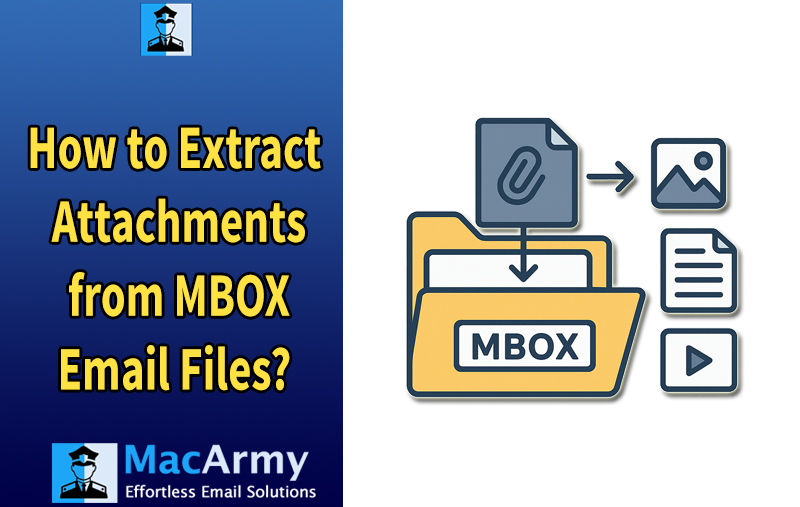Quick Methods to Extract Attachments from MBOX Email Files

MBOX files are widely used to store email messages in many email clients like Thunderbird, Apple Mail, and others. These files not only contain the email content but often hold multiple attachments such as documents, images, and other important files. While attachments enrich the email experience, large or numerous attachments can significantly increase the size of an MBOX file, which in turn raises the risk of file corruption, slower performance, and data management challenges.
This blog post will guide you through different techniques for extracting attachments from MBOX files. We will cover both manual methods for users comfortable with technical steps, as well as automated tools designed to simplify and speed up the extraction process while preserving the original attachment quality. Whether you want to extract attachments for backup, migration, or organizational purposes, the methods discussed here will help you safely and efficiently manage your MBOX email data.
Extract Attachments from MBOX Files
Sometimes, emails stored in MBOX files include large attachments, which can significantly increase the size of your MBOX file and make it difficult to manage.
These large attachments can slow down your email service and may even cause file corruption, rendering your email data inaccessible. To prevent this, it’s essential to either delete or extract attachments from your emails. Since many attachments contain important information, deleting them isn’t always a viable option. Extracting and saving them securely is the best approach.
Benefits of extracting attachments from MBOX files include:
- Extracted attachments serve as reliable backups if the original email or attachment gets corrupted, lost, or deleted.
- Once saved locally, you can access your attachments anytime without relying on an email client.
- Extracted files can be sorted into categorized folders, making it easier to find and manage your data.
- Removing attachments helps protect the integrity of your MBOX file and prevents corruption.
Manually Extract MBOX File Attachments on Mac Using Thunderbird
One effective way to extract attachments from MBOX files is by using the Thunderbird email client along with its useful add-ons like Attachment Extractor. Here’s a step-by-step guide to help you manually extract attachments from MBOX files using Thunderbird:
- Open the Thunderbird application on your Mac system.
- In the Thunderbird window, click on the three horizontal lines (also known as the hamburger menu) located at the top-right corner.
- From the drop-down menu, select Add-ons and Themes.
- In the Add-ons Manager tab, use the search bar to type Attachment Extractor.
- Locate the Attachment Extractor add-on from the search results and click Add to Thunderbird to install it. Follow any prompts to complete the installation.
- Once installed, restart Thunderbird to enable the add-on.
- If your MBOX file is not already loaded, import it into Thunderbird using the ImportExportTools NG add-on or by dragging and dropping the MBOX file into a local folder in Thunderbird.
- Right-click the folder containing your imported MBOX emails, and select Attachment Extractor > Extract All Attachments (or similar option depending on the add-on version).
- Choose the destination folder where you want the attachments saved and start the extraction process.
- Navigate to the selected folder on your Mac to verify all attachments have been saved properly.
How to Professionally Extract Attachments from MBOX Files
Relying on Thunderbird’s Attachment Extractor doesn’t always yield consistent results. Attachments may be missed or saved with errors, which can compromise data integrity. To ensure a more reliable and accurate solution, it’s advisable to use a professional MacArmy MBOX Converter tool.
One such tool is MacArmy MBOX File Converter, which offers a more dependable way to extract attachments and back up your MBOX files. This software converts MBOX files into Outlook-compatible PST format, making it easier to manage emails and attachments in Microsoft Outlook. Additionally, it provides flexible export options, allowing you to save MBOX data in formats such as PST, PDF, MSG, EML, TXT, OLM, and many more. This software offers a preview of mailbox items before saving them in your desired format, ensuring accuracy and transparency during the conversion process. It facilitates smooth migration from MBOX-based email clients to Microsoft Outlook by converting data into the widely supported PST format, which is easy to manage and transfer.
The software preserves the original folder hierarchy and structure, delivering precise and organized results. It also includes advanced features like batch conversion and selective conversion to meet specific user needs. Supporting over 15 MBOX email clients, the tool enables users to convert multiple MBOX files at once, making it ideal for both individual and enterprise-level use.
Conclusion
Attachments can significantly increase the size of MBOX files, leading to slower email performance and a higher risk of file corruption. While deleting attachments is an option, it’s not ideal for preserving important data.
Manually extracting attachments using Thunderbird’s Attachment Extractor offers limited reliability and may not ensure complete or accurate results. A more effective approach is to convert MBOX data into PST format using a professional tool like MacArmy MBOX to PST Converter.
This solution not only allows you to export and manage attachments efficiently, but also provides a secure backup by converting MBOX files into Outlook-compatible PST format. The tool ensures quick conversion, maintains the original folder structure, and supports future access to your email data whenever needed.
